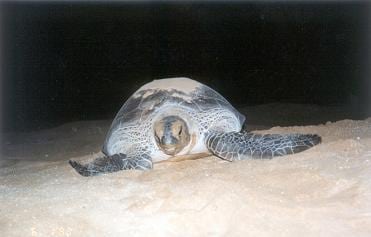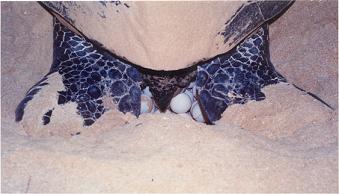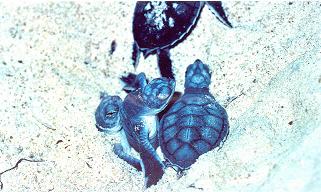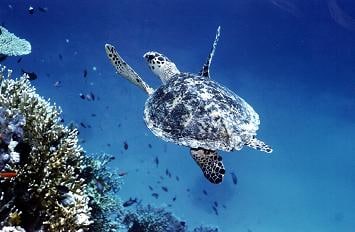Focus for today:
Turtle nesting.
Target key stage:
Key Stage 4: National Science Curriculum, Dual Award, Sc2, 5a: the distribution and relative abundance of organisms in habitats can be explained using ideas of interdependence, adaptation, competition and predation.
Key information:
The waters of the Farasan island are inhabited by several turtle species: leatherback, loggerhead, olive ridley and hawksbills. However, only Green and hawksbill turtles nest in the islands. Females come here every year for in early March to the end of April to lay their eggs. The turtle nesting sites are very scattered over many of the Farasan Islands but each female always comes back to the same beach, the one she was born on. She uses her rear flippers to excavate a pit and a chamber where she deposits a clutch that she covers with sand before she returns to sea. The number of eggs per clutch varies with species: approximately 100 eggs for the green turtle and on average 75 eggs for the hawksbills.
Nesting turtle
Fifty five to sixty days after, the tiny turtles start hatching; they climb upwards, but if they sense heat from the mid day sun they stay put under the surface until the sand cools down in order to avoid sea bird predators and the scorching sunshine. At dawn or in the night the sand seems to come alive as the little turtles scramble their way out; they immediately scurry on towards the water to start their long journey at sea hiding in floating sea grass.
Laying eggs
Because turtles have been severely hunted for their meat and carapace (shell), many species are gravely endangered. In some places of the world, one of the management practices to help survival of the eggs is to excavate the clutch and place it in a safe place until hatching, however, it turns out that sex determination (being male or female) in turtles is affected by the temperature of the eggs during the middle third of the incubation period.
Hatchlings
Scientists have found out that at lower temperatures the eggs lead to males, while at higher temperature only females hatch. The exact temperature threshold that allows both sexes to be born varies with species; it is around 29 (+/- 1) degree Celsius for Loggerheads. This important biological factor ends up dictating how to take care of the clutch in order to avoid generating only male or only females. Nowadays when management practices include excavating, displacing and watching over the clutch, the temperature is carefully monitored. Turtles are not the only animals with temperature dependant sex determination; alligators are also in this category.
Turtles are one of the oceans great sights
In fact the delicate molecular pathways that leads to sex determination and proper development in animals can be affected by many more factors than just temperature. For instance, some chemicals used in the making of certain plastics are found released in the environment in minute quantities. One could think that small amounts are not affecting anything but in reality, these synthetic compounds can mimic certain natural hormones even at very low concentrations and this can have grave consequences. Biologists have already discovered that in the Florida Keys such pollutants are affecting the sex ratio and fertility of alligators…
Question for students/food for thought:
Scientists believe that due to atmospheric pollution the earth is now experiencing a global warming. How do you think this could affect turtle sex ratios (percentage of male/ female), their turtle nesting sites and ultimately how could this affect the turtle populations?
Additional information:
Tonight the Saudi scientists onbaord the Golden Shadow are on turtle watch – they will be dropped on Kaira Island, at 1800 and will remain there until 2400. We’ll report tomorrow how many turtles they observe.



